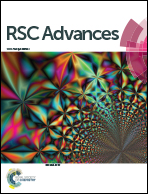The structure and configuration changes of multifunctional peptide vectors enhance gene delivery efficiency†
Abstract
We designed a series of peptide vectors that contain functional fragments with the goal of enhancing cellular internalization and gene transfection efficiency. The functional fragments included a cell-penetrating peptide (R9), a cationic amphiphilic α-helical peptide [(LLKK)3-H6 or (LLHH)3], a stearyl moiety, and cysteine residues. Vectors were also synthesized with D-type amino acids to improve their proteolytic stability. The conformations, particle sizes, and zeta potentials for complexes of these peptides with pGL3 plasmid DNA were characterized by circular dichroism and dynamic light scattering. In addition, cellular uptake of the peptide/DNA complexes and gene transfection efficiency were investigated with fluorescence-activated cell sorting and confocal laser-scanning microscopy. Greater transfection efficiency was achieved with the vectors containing the R9 segment, and the efficiency was greater than Lipo2000. In addition, the D-type C18-c(llkk)3ch6-r9 had about 7 times and 5.5 times the transfection efficiency of Lipo2000 in 293T cells and NIH-3T3 cells at the N/P ratio of 6, respectively. Overall, the multifunctional peptide gene vectors containing the R9 segment exhibited enhanced cellular internalization, a high gene transfection efficiency, and low cytotoxicity.



 Please wait while we load your content...
Please wait while we load your content...